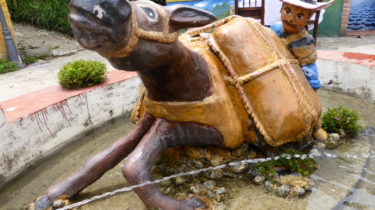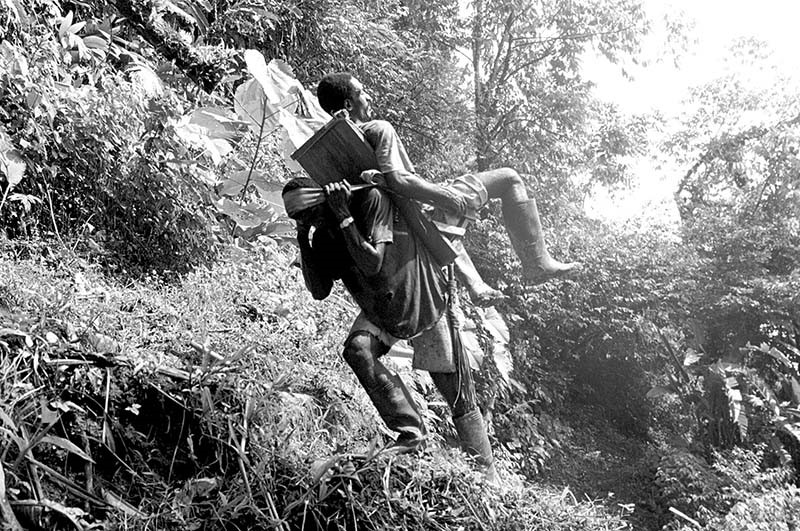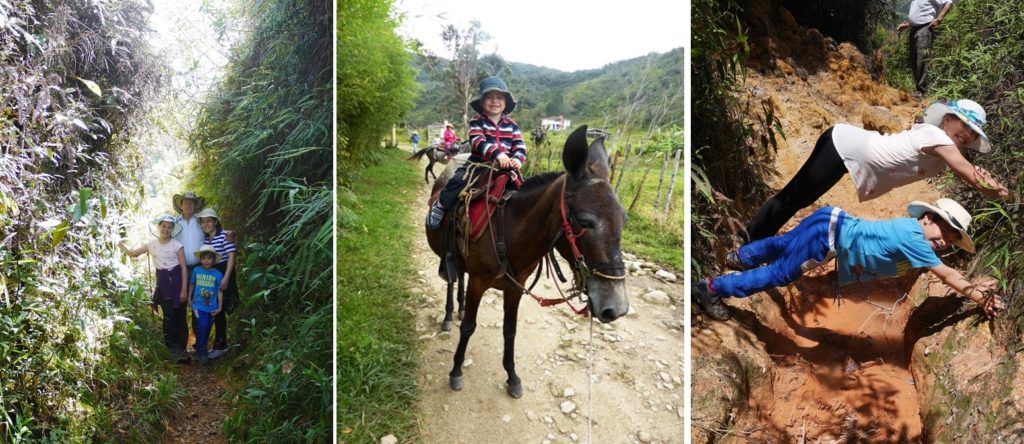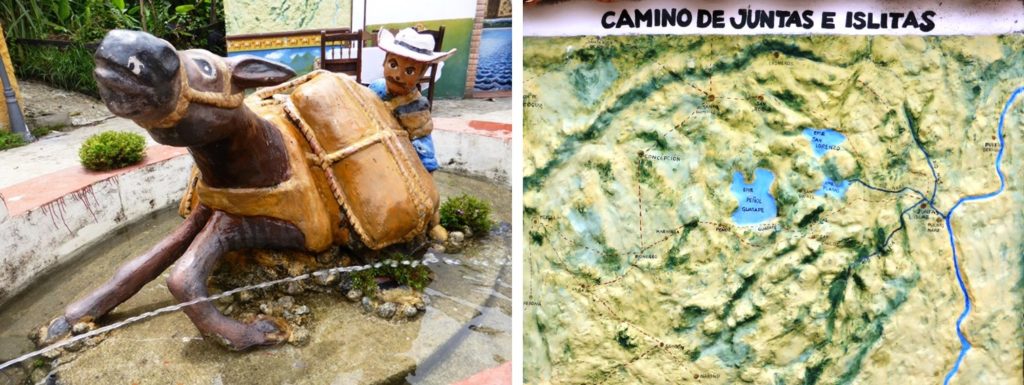Sillateros: the human carriers

by Steve Hide.
A version of this story first appeared in The City Paper in 2015
Colombian roads, or rather lack of them, was a constant moan in journals of visitors to the country in previous centuries, such as the Swedish adventurer Carl Grosselman who spent a month traveling from the Magdalena River to Medellín in 1826, commenting that: “you can’t call this a poor track because you can’t even call it a track.”
Complaining about transportation is common in Colombia with its crowded buses, overloaded trucks, bumpy roads and (when the roads are actually good) exorbitant road tolls. Yes, there is plenty to rant about. But a bit of historical research reveals that this is nothing new: people have moaned about getting around the country since written records began, and I suspect even the pre-Colombian tribes had a strong oral tradition of whinging about the time it takes to trek from the Sun temple to the hot springs, and how many more years until the llama by-pass is finished.
See related posts Guatape: the golden age the arreiros, Alto Baudó: Colombia’s forgotten corner
Grosselman made most of the journey on the back of a silettero, a local porter who strapped a chair to his back to carry wealthier folk like Grosselman over mountain passes. The Swede was clearly uncomfortable “riding on a human as if it was a horse” for 20 days straight, but then advised “not to sympathise with the carriers or you might end up walk- ing yourself or hiring more to spread the load, which could be expensive.”
Of course Colombia was not unique in using human porters, but what is surprising is how long this basic form of transport lasted, in some remote areas as late as the 1870s. This could be explained by the harsh geography of a country trisected by “terrible mountains that give little choice but to go by silletero.” as commented
Alexander von Humboldt in 1801.
The German geographer gave some practical advice on how to ride a silletero’s chair, you must “remain several hours motionless while leaning back” and warned inexperienced riders from jumping from their chair in panic if they thought the porter was about to stumble. In fact a few people had leapt to their deaths in a river as their porter slid and slithered over a slippery bridge made of a single tree trunk. Despite this worry “few wealthy people bother to walk,” wrote Humboldt.

One traveller who did refuse to ride humans was British navy captain Charles Cochrane, who wrote of his travels in the 1820s that the colonists “do not hesitate to spur the flanks of these poor unfortunate men when they fancy they are not going fast enough.” He also noted that most silleteros died before forty from “a ruptured blood vessel.” This in its day was the equivalent of a flat tyre; a burst porter on the mountain pass. In fact there was even a word for it at the time, emparamado, to die on the high Andean grasslands.
The silleteros were not always the victims, and sometimes took revenge on their passenger. According to tales circulating at the time, the porter could toss the chair with rider attached off a cliff then make off with the money. It is hard to say whether this was a real threat, just like our modern-day paseo millionario – being mugged in your Bogotá taxi – is a common fear based on few cases. Though I imagine spending many days in the mountains even with the slightest chance of being decanted into a crevasse by a surly silletero was somewhat more stressful than hailing a street taxi in late-night Zona T.
In the early days of the colony, the silleteros were Indian slaves, but these were replaced over time by paid porters. Some colonial administrators tried to ban the practice as inhumane, before realising there was no alternative transport to get goods and people in and out of some mountain areas. A few laws were passed to control the trade, but this state meddling may have backfired since goods carried on human backs (those carrying goods were known as cargueros) were taxed 60% less than those hauled by animals, incentivising the trade and pushing back the development of mule trails.
This was all bad news for mountainous regions like Antioquia with industrious farmers and merchants hampered by getting produce over those rugged hills to the Magdalena River, the main fluvial transport route through Colombia, on a human back. This dire situation was summed up by Charles Saffray, a French doctor traversing Colombia at the time: “the prosperity of this country depends only on one thing; the roads.”
Roads start taking a toll
In fact soon after the conquest the Spanish had built mule tracks using wooden tree trunks laid horizontally across the path, but these had long rotted by the 1800s and lack of maintenance had created potholes an incredible “30 feet below the original road level,” according to Cochrane, by now cursing his decision to use a mule and not a silletero to cross the Quindio Pass in 1824, his mule now swimming in mud at the bottom of a deep gulley. Think on that next time you whinge at the baches on Calle 19. And just as today, road building and repairs were subject to political forces and protectionism. As far back as the 1780s Antioquia’s administrator, Juan Antonio Mon y Velarde, proposed to “put an end to these problems and complaints” by building new toll routes passable by mule trains. But the process dragged on for many more decades, slowed by silleteros and cargueros who “protested the improved mule tracks,” according to Humboldt. “The weak government that gave in to their protests,” he added, clearly unimpressed by the whole deal.
Change did come, slowly, in the case of Antioquia in the form of the Camino de Islitas in the 1840s. This custom-made mule track – complete with tolls – carved a new route linking the provincial capital of Medellín with the port of Islitas, close to the Magdalena River. Cargos of tobacco, coffee and cacao could be sent all the way to the river packed on mules or oxen (which were slower but did not need shoeing) and the overall journey time was halved now to 15 days.
But despite this innovation there were still complaints, some from the mule drivers, or arrieros, who faced “plague, heat, thirst, and snakes.” One young arrierocommented: “My father would cry when he heard he had to take a cargo down to Islitas.”
Will we ever be happy with transport in Colombia? I doubt it. The philosopher Heraclitus once said “Change is the only constant.” He could equally have said: “Complaining is the only constant.” But having read about Colombia’s silleteros, cargueros and arrieros, I have resolved to complain less. Just a little bit.
Complaining about transportation is common in Colombia with its crowded buses, overloaded trucks, bumpy roads and (when the roads are actually good) exorbitant road tolls. Yes, there is plenty to rant about. But a bit of historical research reveals that this is nothing new: people have moaned about getting around the country since written records began, and I suspect even the pre-Colombian tribes had a strong oral tradition of whinging about the time it takes to trek from the Sun temple to the hot springs, and how many more years until the llama by-pass is finished.
Colombian roads, or rather lack of them, was a constant moan in journals of visitors to the country in previous centuries, such as the Swedish adventurer Carl Grosselman who spent a month traveling from the Magdalena River to Medellín in 1826, commenting that: “you can’t call this a poor track because you can’t even call it a track.”
Grosselman made most of the journey on the back of a silettero, a local porter who strapped a chair to his back to carry wealthier folk like Grosselman over mountain passes. The Swede was clearly uncomfortable “riding on a human as if it was a horse” for 20 days straight, but then advised “not to sympathise with the carriers or you might end up walking yourself or hiring more to spread the load, which could be expensive.”
Of course Colombia was not unique in using human porters, but what is surprising is how long this basic form of transport lasted, in some remote areas as late as the 1870s. This could be explained by the harsh geography of a country trisected by “terrible mountains that give little choice but to go by silletero.” as commented Alexander von Humboldt in 1801.

‘Few wealthy people bother to walk’
The German geographer gave some practical advice on how to ride a silletero’s chair, you must “remain several hours motionless while leaning back” and warned inexperienced riders from jumping from their chair in panic if they thought the porter was about to stumble. In fact a few people had leapt to their deaths in a river as their porter slid and slithered over a slippery bridge made of a single tree trunk. Despite this worry “few wealthy people bother to walk,” wrote Humboldt.
One traveller who did refuse to ride humans was British navy captain Charles Cochrane, who wrote of his travels in the 1820s that the colonists “do not hesitate to spur the flanks of these poor unfortunate men when they fancy they are not going fast enough.” He also noted that most silleteros died before forty from “a ruptured blood vessel.” This in its day was the equivalent of a flat tyre; a burst porter on the mountain pass. In fact there was even a word for it at the time, emparamado, to die on the high Andean grasslands.
The silleteros were not always the victims, and sometimes took revenge on their passenger. According to tales circulating at the time, the porter could toss the chair with rider attached off a cliff then make off with the money. It is hard to say whether this was a real threat, just like our modern-day paseo millionario – being mugged in your Bogotá taxi – is a common fear based on few cases. Though I imagine spending many days in the mountains even with the slightest chance of being decanted into a crevasse by a surly silletero was somewhat more stressful than hailing a street taxi in late-night Zona T.
In the early days of the colony, the silleteros were Indian slaves, but these were replaced over time by paid porters. Some colonial administrators tried to ban the practice as inhumane, before realising there was no alternative transport to get goods and people in and out of some mountain areas. A few laws were passed to control the trade, but this state meddling may have backfired since goods carried on human backs (those carrying goods were known as cargueros) were taxed 60% less than those hauled by animals, incentivising the trade and pushing back the development of mule trails.
This was all bad news for mountainous regions like Antioquia with industrious farmers and merchants hampered by getting produce over those rugged hills to the Magdalena River, the main fluvial transport route through Colombia, on a human back. This dire situation was summed up by Charles Saffray, a French doctor traversing Colombia at the time: “the prosperity of this country depends only on one thing; the roads.”
Mule tracks cut their way
In fact soon after the conquest the Spanish had built mule tracks using wooden tree trunks laid horizontally across the path, but these had long rotted by the 1800s and lack of maintenance had created potholes an incredible “30 feet below the original road level,” according to Cochrane, by now cursing his decision to use a mule and not a silletero to cross the Quindio Pass in 1824, his mule now swimming in mud at the bottom of a deep gulley. Think on that next time you whinge at the baches on Calle 19. And just as today, road building and repairs were subject to political forces and protectionism. As far back as the 1780s Antioquia’s administrator, Juan Antonio Mon y Velarde, proposed to “put an end to these problems and complaints” by building new toll routes passable by mule trains. But the process dragged on for many more decades, slowed by silleteros and cargueros who “protested the improved mule tracks,” according to Humboldt. “The weak government that gave in to their protests,” he added, clearly unimpressed by the whole deal.

Change did come, slowly, in the case of Antioquia in the form of the Camino de Islitas in the 1840s. This custom-made mule track – complete with tolls – carved a new route linking the provincial capital of Medellín with the port of Islitas, close to the Magdalena River. Cargos of tobacco, coffee and cacao could be sent all the way to the river packed on mules or oxen (which were slower but did not need shoeing) and the overall journey time was halved now to 15 days.
But despite this innovation there were still complaints, some from the mule drivers, or arrieros, who faced “plague, heat, thirst, and snakes.” One young arrierocommented: “My father would cry when he heard he had to take a cargo down to Islitas.”
Will we ever be happy with transport in Colombia? I doubt it. The philosopher Heraclitus once said “Change is the only constant.” He could equally have said: “Complaining is the only constant.” But having read about Colombia’s silleteros, cargueros and arrieros, I have resolved to complain less. Just a little bit.
Afternote: in 2017 I visited the Alto Baudó in the Chocó, in the west of Colombia, where Afro-Colombian communities still use sillateros to cross the range that links the Atlantic and Pacific rivers, see my post Alto Baudó: Colombias Forgotten Corner.
